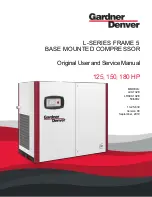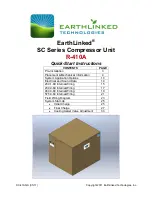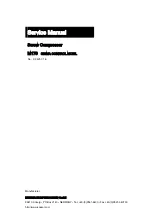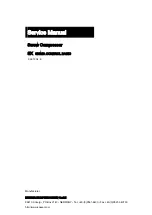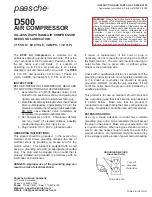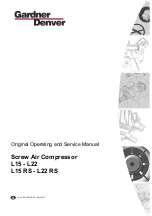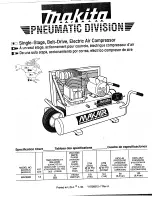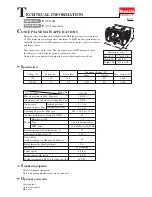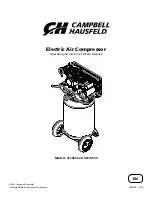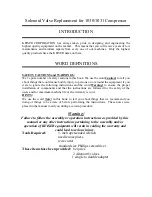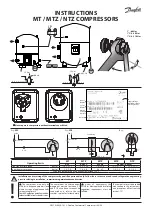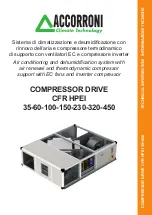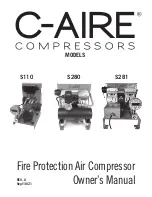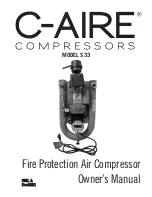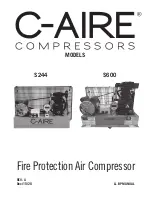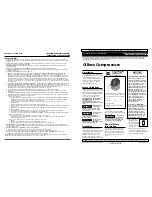
23 Sp
Problema
Posible(s) Causa(s)
Acción a tomar
Manual de Instrucciones
Guía de diagnóstico de averías (Continuación)
5. La unidad está fría, el aceite es muy
espeso
6. Le falta aceite
7. El capacitor está defectuoso
1. El fusible es inadecuado, el circuito está
sobrecargado
2. El calibre o longitud de los cordones de
extensión son inadecuados
3. La válvula de chequeo o el
descargador están dañados
4. Le falta aceite
1. Voltaje bajo
2. El filtro de aire está obstruído
3. La ventilación es inadecuada/la
temperatura ambiental es muy alta
4. El calibre o longitud de los cordones de
extensión son inadecuados
5. Le falta aceite
1. Hay conexiones flojas (conectores,
tuberías, etc.)
2. La llave de drenaje está floja
3. Hay fugas en la válvula de chequeo
1. Exceso de agua en el tanque de aire
2. La humedad es muy alta
1. El presostato está dañado
2. Consumo excesivo de aire
3. Hay una fuga de aire
Los pernos de la base están flojos
Los pernos de las patas están flojos
1. Las válvulas están rotas
2. El filtro de entrada está sucio
3. Hay fugas en las conexiones
5. Use aceite sintético 5W-30 (Mobil 1) y/o espere que la
unidad se caliente
6. Añádale aceite hasta la línea full (lleno) de la varilla
para medir el aceite
7. Reemplácelo o repárelo
1. Cerciórese de que el fusible sea el adecuado, use un
fusible de acción retardada. Desconecte cualquier otro
artefacto que esté conectado al mismo circuito o
conecte el compresor a otro circuito donde no haya
ningún otro artefacto conectado
2. Vea la tabla de cordones de extensión, en la sección de
funcionamiento
3. Reemplácelos o repárelos
4. Añádale aceite hasta la línea full (lleno) de la varilla
para medir el aceite
1. Chequée con un voltimetro
2. Limpie el filtro (vea la sección de Mantenimiento)
3. Mueva el compresor a un área bien ventilada
4. Vea la tabla de cordones de extensión, en la sección de
funcionamiento
5. Añádale aceite hasta la línea full (lleno) de la varilla
para medir el aceite
1. Chequée todas las conexiones con agua enjabonada y
apriételas
2. Apriétela
3. Desconecte la válvula de chequeo, límpiela o
reemplácela
No desconecte la válvula
de chequeo con aire en el
tanque; purgue el tanque antes de hacerlo.
1. Drene el tanque
2. Mueva el compresor a un área menos húmda; use un
filtro en la línea de aire
1. Reemplácelo
2. Disminuya el consumo de aire; el compresor no es el
adecuado para suministrar la cantidad de aire
requerido
3. Repare o reemplace la pieza que tiene la fuga
Apriete los pernos de modo que la arandela de goma esté
un poco comprimida
Apriete los pernos ubicados debajo del tanque
1. Un técnico autorizado debe reparar la unidad
2. Limpie o reemplace el filtro de entrada
3. Apriételas
!
PELIGRO
Los fusibles se queman /
el cortacircuito se activa
con frecuencia
El sistema de protección
térmica apaga la unidad
constantemente
La presión del tanque
baja cuando se apaga el
compresor
Exceso de humedad en el
aire expulsado
El compresor funciona
continuamente
El compresor vibra
El compresor se desplaza
sobre la superficies duras
La presión de aire
suministrado es inferior a
lo normal
Oil Lubricated Portable Air Compressor
2
Operating Instructions
General Safety
(Continued)
Motors, electrical
equipment and controls
can cause electrical arcs
that will ignite a
flammable gas or vapor. Never operate
or repair in or near a flammable gas or
vapor. Never store flammable liquids or
gases in the vicinity of the compressor.
6. Do not stand on or use the pump or
unit as a handhold.
Disconnect power
and depressurize
system before servicing air compressor!
(Turn pressure regulator knob fully
clockwise after unplugging compressor.)
7. Follow all local electrical and safety
codes, as well as the National
Electrical Code (NEC) and the
Occupational Safety and Health Act
(OSHA).
All electrical work
should be done by
a qualified (licensed or certified)
electrician. On a properly wired circuit,
the black wires supply a voltage
potential even when the unit is off.
8. Unit must be securely and adequately
grounded. See grounding
instructions and extension cord
information in this manual.
!
WARNING
!
WARNING
!
WARNING
9. Wear safety glasses
and use hearing
protection when
operating the pump
or unit.
10. Do not wear loose clothing or jewelry
that will get caught in the moving
parts of the unit.
Compressor parts
may be hot even if the
unit is stopped.
11. Keep fingers away
from a running compressor; fast
moving and hot parts will cause
injury and/or burns.
12. If the equipment should start to
vibrate abnormally, STOP the motor
and check immediately for the cause.
Vibration is generally a warning of
trouble.
13. To reduce fire hazard, keep motor
exterior free of oil, solvent, or
excessive grease.
14. To avoid spontaneous combustion,
keep cleaning rags and other
flammable waste materials in a
tightly closed metal container and
dispose of waste rags into approved
metal waste cans.
!
CAUTION
Figure 1 - Side View of Compressor
Never remove or
attempt to adjust
safety valve. Keep safety valve free from
paint and other accumulations.
Never attempt to
repair or modify a tank!
Welding, drilling or any
other modification will
weaken the tank
resulting in damage from rupture or
explosion. Always replace worn or
damaged tanks.
15. Tanks rust from moisture build-up,
which weakens the tank. Make sure
to drain tank daily and inspect
periodically for unsafe conditions
such as rust formation and corrosion.
16. Fast moving air will stir up dust and
debris which may be harmful. Release
air slowly when draining moisture or
depressurizing the compressor
system.
Do not spray flammable
materials in vicinity of
open flame or near
ignition sources
including the compressor unit.
17. Do not smoke when spraying paint,
insecticides, or other flammable
substances.
!
WARNING
!
DANGER
!
WARNING
Drain Cock (one on each tank)
Check Valve
(located below
Pressure Switch)
ASME Safety
Valve
Pressure
Regulator
Knob
Regulated
Pressure
Gauge
Air
Outlet
Dipstick
Oil Drain
Air Deflector
(Air Filter Underneath)
Pressure Switch
Tank
Figure 2 - Top View of Compressor (handle not shown)
Tank
Auto/Off
Knob
Tank Pressure
Gauge
Start up
Unloader
Auto/
Off
Knob
www.chpower.com









